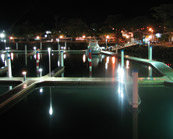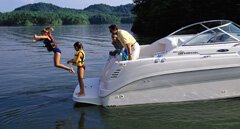Nothing is harder on your boat than neglect, and neglect is exactly what recreational boats are subjected to when cold weather settles in. But proper lay-up techniques can minimize the ill effects winter disuse will have on your boat.
A prime objective of lay-up is to prepare your boat for the inevitability of freezing conditions. Fluids must be removed or protected, and nothing should be aboard that might be damaged by low temperatures.
Prepare a checklist
The most important tool for properly winterizing your boat is a pencil. Unless you prepare a comprehensive checklist--and follow it--chances are good that you will miss a step or two. Spending a few minutes now tailoring the generic checklist below to your specific requirements will next spring save you hours of dealing with the consequences of an oversight.
Empty lockers of perishables
Also take off any cans or bottles containing liquids that could freeze.
Freeze proof the toilet
Every toilet I have ever removed has dumped water (I hope) on the cabin sole when turned sideways to pass through the head door, so pumping a toilet "dry" may prove inadequate. Disconnect the inlet hose from the closed seacock and submerge it in a 50-50 mix of water and propylene glycol antifreeze. Operate the head until you are sure the antifreeze has passed through the toilet and all lines.
If you have an onboard sewage treatment system, follow the manufacturer’s instructions for winterizing.
NOTE: For all pump, tank, and hose winterizing, use only non-toxic propylene glycol antifreeze. Never use the ethylene glycol type--common automotive antifreeze--which is poisonous.
Pump out the holding tank
If the holding tank was empty and clean when you treated the toilet, you can leave the antifreeze mix in the tank, but an empty tank is better.
Empty all freshwater tanks
Antifreeze is not practical because a 50-50 solution is required, and you then have to empty the tanks in the spring anyway. Remember that the pump pickup is above the bottom, so you will have to pump or sponge the tank dry through the clean-out port. This is a good time to wipe down the interior of the tank with a chlorine solution.
Drain the water heater
If your water heater has an electrical element; electrically disconnect the heater before you drain it. Because the element will burn out unless submerged, attach a tag to the electrical connection to remind you to refill the tank before restoring the connection.
Drain or protect pumps and hoses
Even though you are going to drain pumps and hoses, it is advisable to pump a 50-50 antifreeze solution through them to protect pockets or low spots that could be harboring residual water. If your boat is fitted with a water heater--now empty--bypass it (by disconnecting inlet and outlet hoses and connecting them together) so the antifreeze reaches the hot-water side of your plumbing.
NOTE: For uncomplicated water delivery configurations, draining--without the antifreeze treatment--will be adequate as long as you make sure no water remains in pumps or low spots in hoses.
Drain the accumulator
Water doesn’t actually flow through your accumulator tank, so pumping antifreeze through the lines puts very little into the accumulator--like pouring more water into a full jug. If it doesn’t drain when you remove the hoses, blow through the T connector, or dismount the tank and shake it empty.
Protect refrigeration and air-conditioning condensers
Internal loops in the water passages typically prevent complete drainage, so disconnect the raw-water connection from the closed seacock and submerge it in a 50-50 antifreeze mix. Run the system to force the antifreeze through the pump and all lines. Drain.
Drain baitwell and/or wash down pumps and hoses
Check valves can prevent the lines from draining completely, so you may need to disconnect hoses at both ends. Baitwell tanks must, of course, be empty.
Empty shower sumps
Don’t expect the pump to leave the shower sump dry. You will need to release the sump and pour it empty or sponge the sump dry.
Empty propane lines
Light a burner on the galley stove--and any other gas appliances--then turn off the manual valve on the propane tank(s). When the burner(s) goes out, close it and flip the solenoid switch to off.
Remove sails and canvas
Exposing awnings and sails to winter storms--even folded or furled--definitely shortens and too often terminates their lives.
Lubricate furling systems
If your furling system requires lubrication, this is the time to do it.
Service winches
If you do this in the fall, you will know that the internal components are well protected from corrosion for the winter, and the winches will be ready for service in the spring without further attention.
Remove electronics
Spending winters in a warm, dry place prolongs the life of your electronics. Taking them off the boat also eliminates the risk of theft. Spray the open connectors with a moisture-displacing lubricant to protect the contacts from the formation of corrosion. Extract the log impeller and replace it with the plug.
Protect batteries
If wet-cell batteries are allowed to discharge the electrolyte becomes pure water, which will freeze and ruin the battery. On small boats, bring batteries to a fully charged condition, then remove them from the boat and store in a dry, cool (not frigid) location. Wash and thoroughly dry the tops of stored batteries to reduce the potential for self-discharge. Do not leave stored batteries connected to a portable charger. Unless the charger turns off completely--few do--the batteries will suffer damage. However, stored batteries should be brought to full charge once a month, so post yourself a reminder.
If the batteries will be stored aboard because they are too heavy for convenient removal, they must be maintained in a full charge condition all winter. This requires a power connection and a charger with a "float" stage.
Winterize the engine
A helpful checklist for this essential component of fall lay-up is available as a separate Don Casey Shows You How... sheet.
Scrub the exterior
Flushing salt residue from hardware and rigging reduces the potential for corrosion, and grime left on fiberglass or painted surfaces until spring will be that much harder to remove.
Touch up brightwork
Do not leave damaged spots bare all winter.
Wax fiberglass surfaces
A light coat of soft wax will protect the fiberglass from dirt and moisture. There is no need to buff it until spring
Empty the bilge
Bilge pumps typically fail to remove all water from the bilge. Any that remains will freeze. Pump and sponge the bilge completely dry.
Open drain plug
Trailerable boats should be stored with the drain plug removed and the bow elevated so precipitation that finds its way inside the boat will drain out. Sailboats are sometimes fitted with a garboard drain plug to serve the same function when wintering ashore. Remove the plug and tag it conspicuously so you cannot forget to reinstall it in the spring.
Close all seacocks except cockpit drains
If the boat is hauled, lubricate and exercise the seacocks--all of them--before closing them for the winter. Out of the water an open seacock still admits moisture, frigid air, and perhaps vermin, so close them.
Vacuum, clean, and polish
Dirt and grease promote the growth of mold and mildew. Vacuum cushions, clean cabinet interiors, and damp-wipe all hard surfaces. Scrub the interior of refrigerators or ice chests with a mild chlorine solution. Place an open box of baking soda inside and leave the lid open or off.
Prop up cushions
Air circulation to all sides of cushions is essential. Better still, remove all loose cushions from the boat entirely and store them somewhere warm and dry for the winter. This also applies to other fabric items aboard, like linens, blankets, and PFDs.
Open lockers and drawers and hatches
Adequate air circulation is the best way of combating mildew. Latch-hooks can be employed to hold cabin and locker doors slightly ajar. Prop bilge access and other compartment hatches open. Hanging a mildew control bag in the cabin is a good precaution.
Cover
A canvas or shrink-wrap winter cover doesn’t just keep precipitation out of the boat’s interior, it also protects the deck. In the winter, moisture between hardware and the deck or in minute cracks in the gelcoat repeatedly freezes, jacking the cracks wider with each cycle.
Covers should be padded to prevent chafe, well secured to resist buffeting, and well ventilated to allow the circulation of air beneath the tarp.


